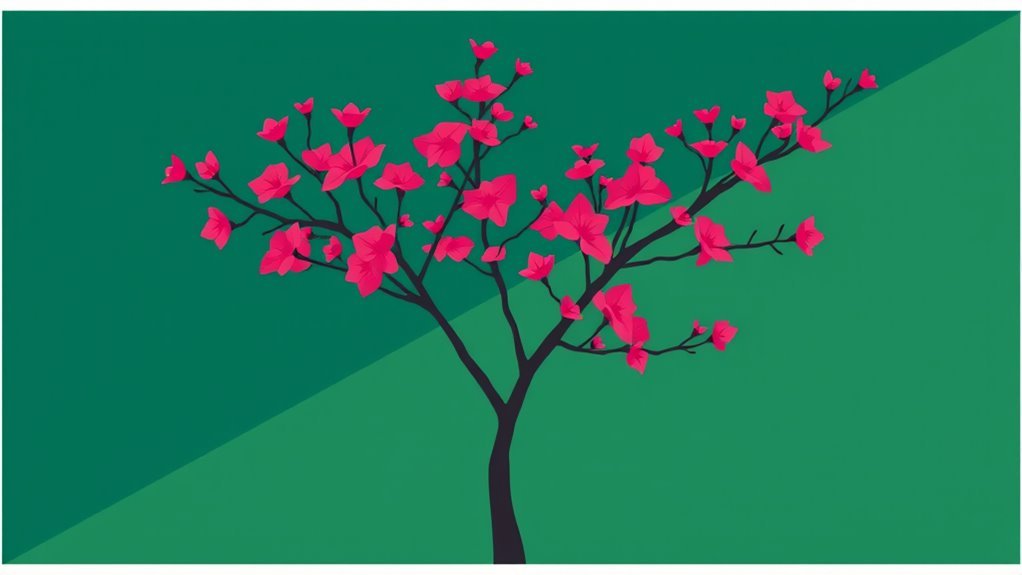The Eastern Redbud, scientifically named Cercis canadensis, is part of the Fabaceae family, also known as the legume family. This family is acknowledged for its diverse plants, including trees, shrubs, and herbaceous species. The Eastern Redbud is valued for its striking pink to purple flowers and heart-shaped leaves. It plays a noteworthy role in local ecosystems, supporting various wildlife and promoting soil health. Additional information about its ecological importance and cultural relevance awaits.
Main Points
- The Eastern Redbud is scientifically named Cercis canadensis.
- It belongs to the Fabaceae family, commonly known as the legume family.
- The genus Cercis includes related species such as Cercis siliquastrum and Cercis chinensis.
- Members of the Fabaceae family are known for features like compound leaves and distinctive flower shapes.
- The Fabaceae family is significant for its ability to fix nitrogen in the soil, enhancing fertility.
Overview of the Eastern Redbud
The Eastern Redbud, scientifically known as Cercis canadensis, is a small deciduous tree native to the eastern United States. Typically reaching heights of 20 to 30 feet, it is defined by its heart-shaped leaves and vibrant pink to purple flowers that bloom in early spring.
These flowers emerge before the leaves, creating a striking visual display against the backdrop of still-bare branches. The tree's bark is smooth and gray when young, becoming furrowed with age.
Eastern Redbuds thrive in well-drained soil and prefer full sun to partial shade, making them suitable for various environments, including gardens and parks. Additionally, they are often used for ornamental purposes due to their aesthetic appeal.
This species provides habitat and food for various wildlife, contributing to local ecosystems. As a symbol of spring, the Eastern Redbud holds a special place in the hearts of many who appreciate its beauty and resilience.
Taxonomy and Classification

Taxonomy and classification of the Eastern Redbud reveal its scientific naming conventions and hierarchical placement within plant families.
This species belongs to the genus Cercis and is classified under the Fabaceae family, highlighting its botanical relationships.
An overview of related species provides further context to its ecological and evolutionary significance.
Scientific Naming Convention
Scientific naming conventions are vital for accurately classifying and identifying organisms within the biological world. This system, known as binomial nomenclature, assigns each species a two-part Latin name consisting of the genus and species.
The genus name is capitalized, while the species name is written in lowercase, both italicized or underlined to signify their scientific status. These conventions provide a universal language for scientists, facilitating communication and research across different languages and regions.
Family and Genus Classification
Classification within the biological hierarchy involves organizing living organisms into categories based on shared traits.
The Eastern Redbud, scientifically known as Cercis canadensis, belongs to the family Fabaceae, commonly referred to as the legume or pea family. This family is known for its considerable diversity and ecological importance.
Within the Fabaceae, the genus Cercis houses various species, defined by their distinctive flowering patterns and heart-shaped leaves. The Eastern Redbud is particularly noted for its striking pink to purple flowers that bloom in early spring, contributing to its popularity in ornamental horticulture.
Understanding the family and genus classification of the Eastern Redbud provides insight into its ecological relationships and evolutionary history within the broader context of plant taxonomy.
Related Species Overview
The Eastern Redbud, Cercis canadensis, is part of a diverse genus that includes several related species with similar characteristics.
Among these species, Cercis siliquastrum, commonly known as the Judas tree, is notable for its striking pink flowers and is often found in southern Europe and western Asia.
Another related species, Cercis chinensis, or the Chinese redbud, features yellowish flowers and is native to China.
Additionally, Cercis occidentalis, known as the Western redbud, is suited to the southwestern United States and exhibits a more drought-resistant nature.
These species, while sharing the common traits of the genus, exhibit unique modifications to their respective environments, contributing to the ecological diversity within the Cercis family.
Characteristics of the Fabaceae Family

The Fabaceae family, commonly known as the legume family, exhibits distinctive plant structures, including compound leaves and unique flower shapes.
This family plays a vital ecological role by improving soil fertility through nitrogen fixation and providing habitat and food for various organisms.
Additionally, many species within Fabaceae have important uses in agriculture, medicine, and industry.
Plant Structure and Growth
Characteristics of the Fabaceae family reveal a diverse array of plant structures and growth patterns. Members of this family typically exhibit a range of growth forms, including trees, shrubs, and herbaceous plants.
Their leaves are often compound, featuring multiple leaflets arranged along a central stalk, which improves photosynthesis efficiency. The root systems frequently include nodules that host nitrogen-fixing bacteria, contributing to soil fertility.
Fabaceae plants usually possess distinctive flowers with a unique petal arrangement, often forming a banner, wings, and a keel. These modifications not only aid in pollination but also guarantee successful reproduction.
In addition, their fruits are generally legumes, which dehisce to release seeds, showcasing an evolutionary strategy for dispersal and survival.
Ecological Importance and Uses
Members of the Fabaceae family play a substantial role in ecosystems and human economies. These plants, commonly known as legumes, contribute considerably through various ecological functions and uses. Their ability to fix nitrogen enriches soil fertility, promoting healthier plant growth.
Additionally, many Fabaceae species provide crucial habitats for wildlife.
Key contributions of the Fabaceae family include:
- Soil Improvement: Nitrogen-fixing capabilities improve soil quality.
- Food Source: Legumes are a staple in human diets, rich in protein and essential nutrients.
- Biodiversity Support: They offer resources and shelter for numerous species, promoting ecological balance.
Ecological Importance of the Eastern Redbud

Although often celebrated for its striking beauty, the Eastern Redbud (Cercis canadensis) plays an essential role in its ecosystem. This deciduous tree serves as a vital source of early spring nectar for pollinators, including bees and butterflies, aiding in their life cycles and promoting biodiversity.
Its heart-shaped leaves provide habitat and forage for various wildlife, including birds and small mammals. The Eastern Redbud's ability to thrive in diverse soil conditions allows it to stabilize soil and reduce erosion, contributing to healthier environments.
Additionally, this tree plays a role in nitrogen fixation, enriching the soil and improving its fertility. As a keystone species, the Eastern Redbud supports a range of organisms, from insects to larger fauna, nurturing a balanced ecosystem.
Its presence in woodlands and gardens not only improves aesthetic value but also underlines the interdependence of flora and fauna within natural habitats.
Cultural Significance and Uses

The Eastern Redbud (Cercis canadensis) holds considerable cultural value across various regions, often symbolizing renewal and the arrival of spring.
This tree's vibrant pink blossoms serve as a celebrated sight in gardens and public parks, marking the changing of seasons and the rejuvenation of nature.
Beyond its aesthetic appeal, the Eastern Redbud has found various uses in cultural practices and traditional medicine.
- Symbol of Love: In some cultures, its blooms represent love and affection.
- Culinary Uses: The young pods and flowers are edible, often used in salads or as garnishes.
- Craft and Art: Wood from the Eastern Redbud is utilized in crafting and woodworking, appreciated for its unique color and grain.
These attributes not only improve its significance in landscaping but also underscore its role in cultural traditions and local practices.
Connections With Other Fabaceae Members
Connections among members of the Fabaceae family reveal captivating similarities and shared characteristics, particularly in their growth habits and ecological roles. Many Fabaceae species, including the Eastern Redbud, exhibit a range of forms, from small ornamental trees to sprawling legumes.
This family is known for its ability to fix nitrogen in the soil, a trait shared by various members, which improves soil fertility and supports surrounding plant life.
In addition, the presence of compound leaves and vibrant flowers is common among Fabaceae, attracting diverse pollinators. The Eastern Redbud's pink blossoms serve as a prominent example of this floral diversity.
Moreover, the family contributes considerably to ecosystems by providing food and habitat for wildlife.
Through these connections, Fabaceae members demonstrate their importance not only in horticulture but also in promoting biodiversity and ecological health. Their interrelated growth patterns and functional roles showcase the complex relationships within this botanical family.
Conservation and Growing Tips
Understanding the ecological significance of the Fabaceae family, including the Eastern Redbud, highlights the importance of conservation efforts and proper cultivation techniques.
Preserving these plants not only contributes to biodiversity but also supports numerous wildlife species that rely on them for sustenance.
To successfully grow Eastern Redbuds while promoting their conservation, consider the following tips:
- Select Native Varieties: Choose local cultivars that are well-adapted to the regional climate and soil conditions.
- Provide Adequate Space: Guarantee that Eastern Redbuds have enough room to grow, as they can reach a height of 20-30 feet, avoiding overcrowding with other plants.
- Maintain Soil Health: Use organic mulch and compost to enrich the soil, promoting healthy root development and minimizing competition from weeds.
Common Questions
What Is the Ideal Soil Type for Eastern Redbud Growth?
The ideal soil type for best growth includes well-drained, loamy soil enriched with organic matter. This environment supports healthy root development and improves the tree's ability to withstand drought and other environmental stresses effectively.
How Long Do Eastern Redbud Trees Typically Live?
The lifespan of Eastern Redbud trees typically ranges from 20 to 30 years. Nevertheless, with ideal care, some individuals may thrive for up to 50 years, showcasing their resilience and flexibility in various environments.
Are Eastern Redbuds Safe for Pets?
The safety of eastern redbuds for pets is generally confirmed, as these trees are non-toxic. Nevertheless, pet owners should still monitor their animals to prevent any accidental ingestion of leaves or flowers, which could cause mild digestive issues.
Can Eastern Redbuds Tolerate Drought Conditions?
Drought conditions can challenge many plants, but certain species exhibit resilience. Eastern redbuds demonstrate moderate drought tolerance, thriving in well-drained soils while requiring regular watering during prolonged dry spells to maintain peak health and growth.
What Pests Commonly Affect Eastern Redbud Trees?
Common pests affecting these trees include aphids, scale insects, and spider mites. These pests can cause considerable damage by feeding on leaves and sap, potentially leading to reduced vigor and general health of the tree.

